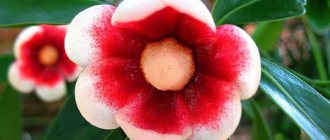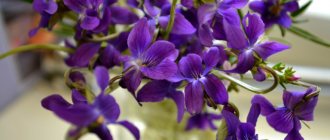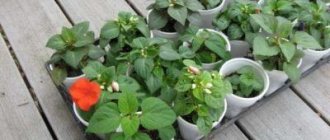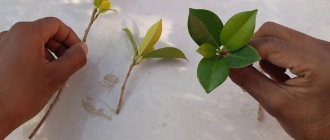The common Radermacher plant is a tree popular with gardeners. It is famous for its leaves, which shine due to their gloss. The culture is not capricious in terms of care and growing conditions. It can even be kept indoors.
For the first time, indoor Radermachera appeared in Asia. The family to which the tree belongs is called bignoniaceae. In nature, the crop can grow up to thirty meters in height. It has the appearance of a flowering tree.
general information
Radermachera (lat. Radermachera) got its name in honor of the Dutch scientist who found it in the forests of Southeast Asia. It belongs to the Bignoniaceae family and has 16 species in the genus. In the natural environment it lives up to 20–30 years, but even at home it can delight the owner for decades.
Expert opinion
Mokhov Andrey Petrovich
Graduated from KubSAU, specialty: agronomy
Chinese Radermachera (Radermachera sinica) is the only representative of the genus among indoor plants.
You can buy Radermachera online or at a flower shop. The price depends on the size and starts from 500 rubles for a tree 20–25 cm high. A plant about a meter in height will cost about 2,500 rubles.
The china tree is similar in appearance to ash, ficus, hibiscus, laurel and coffee tree.
The snake tree, despite its name, is not poisonous. Moreover, it perfectly purifies the air.
Radermachera species
The Radermachera family includes 17 studied species. Most of which are completely unsuitable for living at home due to their large size.
Radermachera sinensis grows well at home ; it will be written about further below. This is a beautiful shrub from 1 to 2 meters in height with a beautiful spreading crown. The leaves are long, 40-50 cm long and 15-20 cm wide. Leaves with jagged edges are dark green.
Radermachera Kunming is a small tree, about 40-60 centimeters, only when it reaches this size does the plant begin to bloom. You can only find them in Thailand; in all other places there are only private collections.
Radermacher Eugenia, better known as jasmine tree, is common in northern Laos, Thailand, Hainan Island and Burma. A plant with orange flowers, reaches a length of 20 meters.
Radermacher Rami flora grows in the tropical forests of Borneo. The tree reaches a length of up to 30 meters, a narrow trunk no more than 30 centimeters in diameter. Plant with fruits, gray leaves, yellow flowers.
Radermachera arboreal is an annual plant growing in Indian forests, where drought is most common. The crown during the flowering period is distinguished by its beauty. On the crown of the trees, among the bright green leaves, the length of which is about 100 centimeters, there are small inflorescences. The inflorescences of this plant are similar to those of gladioli (small funnel).
All types of Radermachera are very fond of the sun, good lighting (at home), warmth, optimal temperature 20 - 25 C and moisture, with the exception of those species that grow in dry places.
Photo gallery
It has a main trunk and several horizontal shoots that become woody over time. Their surface is smooth and covered with gray-green bark.
A distinctive feature of Radermachera are the “lentils” - small oval thickenings on the branches.
Long oval or ovoid leaves grow close to each other. They are glossy with jagged edges. Initially they have a light green color, but over time they darken from the middle.
The emerald tree almost never blooms indoors. The first buds on it can be seen only after 10–15 years. In the wild, they appear in the summer directly on the trunk or in the axils of the leaves and are very similar to bells. The color is white, cream or yellow-orange.
Expert opinion
Mokhov Andrey Petrovich
Graduated from KubSAU, specialty: agronomy
The flowers open only at night and emit the scent of cloves, cinnamon or jasmine.
Botanical characteristics
The genus Radermachera has about sixteen species and they are included in the Bignoniaceae family. Radarmacher owes its name to the botanist and amateur from Holland Jacob Radermacher. There was another interesting name for this tree, but alas, it was not widely used: Chinese stereospermum (Stereospermum sinicum).
The native area of this extraordinary tree can be considered South-Eastern China, the island of Taiwan, from where it was brought in the second half of the eighties of the twentieth century. The Radermacher flower has become one of the favorite indoor plants due to its unpretentiousness and ease of growing.
Presumably, due to the extraordinary beauty of the leaves, Radermachera is popularly called the “Emerald Tree”. Other interesting names for this unusual branching tree in everyday life include Serpent Tree, China Doll, and indoor ash.
Many species of Radermachera, a small genus, are huge trees, reaching thirty meters in height with trunks about one meter in diameter. In uncultivated nature or in greenhouse conditions, large yellow, white or gray-yellow, bell-like, cylindrical flowers, reaching seven centimeters in diameter, bloom unusually beautifully on the Radermacher only at night.
This indescribable beauty emits a pleasant smell similar to the smell of carnation flowers. The most interesting thing is that Radermacher flowering can only be seen in natural wild conditions, and a houseplant can bloom only after fifteen years of age, and even this happens quite rarely.
Radermachera in nature is a tall, spreading tree, often with several trunks. Its height reaches 30-40 m. The diameter of the trunk can reach up to 1 m. The house plant is smaller in size, it is a lush spreading shrub up to 2 m high. Horizontal woody shoots grow along the main vertical trunk. They are covered with grey-green smooth bark.
On young branches, long feathery leaves grow close to each other. The petioles bear oval or ovoid leaves. The length of a whole leaf reaches 20-70 cm, with a width of 15-25 cm. Individual leaves are 2-4 cm long. They have long, pointed ends and smooth or palmate sides.
Radermachera blooms after 15 years of age. In summer, single bells appear in the leaf axils or directly on the trunk. Sometimes they gather in loose racemose inflorescences. Each bud has a very short peduncle. The length of the flower calyx reaches 7 cm. The color can be cream, white or yellow-orange.
After pollination, dry seed pods ripen. They contain small brown seeds with lionfish.
Signs and superstitions
Radermacher absorbs negative energy and helps you focus on important things. It is believed that the tree activates the spiritual chakras and opens channels of communication with a higher power, therefore it is suitable for people engaged in spiritual practices.
Is your Radermacher growing?
If a plant dies unexpectedly, it is believed that it has warded off a strong evil eye from its owner. According to Feng Shui, indoor ash has a beneficial effect on the atmosphere of the home. It is also a symbol of education.
Radermacher cannot tolerate tobacco smoke.
Selecting a location
Tropical culture retains its decorative appearance in good lighting - the length of daylight should be at least 12 hours. When choosing a location, you should take into account that direct sunlight causes leaf burns, so western or eastern windows are preferable. It is acceptable to place a large tree near a window. The crown will develop evenly if the pot is rotated regularly.
In winter and on cloudy days, the lack of light is compensated by illumination, otherwise the internodes will stretch out and the branches will take the shape of a vine. When placed on southern windows, protection from bright rays should be provided.
The flower does not tolerate the smell of tobacco smoke, air fresheners, perfume and reacts by dropping leaves. The kitchen is not the best place for him.
Temperature
At home, the tropical tree adapts well and adapts to the room temperature, easily tolerating the summer heat and high temperatures in the winter. In this case, you need to place a container of water nearby.
There is no need to artificially lower the temperature to create conditions for sleep, because Radermachera does not bloom. But sometimes she is provided with coolness in the winter, watered less often (once every 3-4 days), not fed, and given the opportunity to rest. After a period of dormancy, the tree begins to grow actively and suffers less. You cannot lower the temperature below 11 °C - the flower may get sick.
Humidity level
The flower's homeland is Asian regions with a moderately humid climate, so it does not tolerate excess moisture well, but will tolerate heat and heat well with sufficient moisture.
To maintain a normal level of humidity, it is enough to place containers of water nearby, put moss and expanded clay in a tray and regularly moisten them, and spray the crown.
Advice! When the heating devices are turned on, it is recommended to “bathe” the flower under a warm shower, covering the soil with film. After this, wait until the drops on the leaves dry and take the pot out of the bathroom. The procedure, in addition to moisturizing, is hygienic.
How to form a radermachera in bonsai style
- Plant it in a small container (take not very fertile soil).
- Apply fertilizers rarely and in minimal quantities.
- When replanting, trim the roots.
- Remove excess side shoots, buds and twigs.
- Twist, bend and weight the branches using weights and wire until they become woody.
- Turn the plant with different sides towards the light so that the crown is formed evenly.
- Cut the bark to age the tree.
Carry out all procedures for forming a tree in the spring and summer and only after it has strengthened in the pot.
Pruning of branches and roots should be aimed at balancing the proportions of the bonsai above and below ground.
Common varieties
Bouvardia flower: home care and methods of propagation
Radermachera (Latin Radermachera) belongs to the bignoniaceae family and has about 17 different species.
The most common types of Radermachera:
Kunming
A Thai variety that begins flowering at a height of half a meter. Its flowers are painted in a delicate milky color with yellow centers. It can be found in private gardens in tropical countries.
Blooming Thai tree variety
Ignea
Another variety comes from Thailand. The tree is better known as “jasmine” and reaches a height of 20 meters. It is distinguished by very unusual and bright flowering - fiery red flowers bloom directly on the trunk of the plant.
Ignea is one of the most striking varieties of Radermachera
Ramiflora
It grows exclusively in the tropics of Borneo. It has an impressive height of up to 30 m, and a relatively narrow trunk of up to 30 cm in diameter. The flowers of the tree are large, soft orange in color. Leaves with a grayish tint.
Flowers of this variety can reach 60 cm in length
Xylocarpa
This is an Indian variety of tree. It has delicate white flowers growing densely on the trunk of the plant;
This variety does not have such lush landscaping
Chinese
A popular type of indoor radermachera. The Chinese chrysalis is a long-lived plant - in natural conditions, the age of trees reaches 25-30 years. And if kept indoors with proper care, it will delight you for decades.
Indoor Radermachera has bright green leaves.
Home care
Caring for an emerald tree does not require a lot of time and effort. The main thing is good lighting and proper care, which has seasonal characteristics.
| Season | Temperature | Humidity | Lighting |
| Spring | 20–22˚С, no drafts, diffused light. | Increased | Bright diffused light. Avoid direct sunlight. |
| Summer | |||
| Autumn | Not lower than 10–13˚С. Optimally 16–18˚С. No drafts. | Adapts to dry air | The brightest place. You need to use phytolamps. |
| Winter |
Winter is the tree's dormant period.
Radermachera grows best in moderate humidity to provide it with the right conditions:
- place the pot in a tray with damp expanded clay, sphagnum or pebbles;
- spray leaves in hot weather;
- Once every 10 days, give the plant a cool shower (cover the ground with polyethylene).
Expert opinion
Mokhov Andrey Petrovich
Graduated from KubSAU, specialty: agronomy
When immersing the pot in expanded clay, moss or pebbles, make sure that the bottom does not touch the water.
The plant loves bright, diffused light. Therefore, place it on southwest or southeast windows. In this case, the leaves should not touch the glass. When placing the tree in the south, make sure that direct sunlight does not fall on it.
Care
For normal development at home, the culture must be provided with proper care.
Lighting
The flower grows best in partial shade, so it is good to place the flowerpot with the plant in an area of the room with diffused lighting.
Radermacher can also be placed on the north window of the apartment, but in winter the crop will not have enough natural light (additional light will be needed).
When growing on southern windowsills, it is important to protect the flower from direct sunlight with some object or transparent tulle.
In this regard, in the summer, a pot with a plant is placed on eastern or western windows.
Advice! Constantly turn the radermacher towards the sun, which will prevent individual branches from being pulled out.
Temperature
During the growing season, the room temperature is set within 20-25 degrees. In such conditions, the plant can survive the winter, but in the cold season it is advisable to reduce the temperature to 14-18 degrees. The flower needs ventilation, but Radermachera sheds its leaves when exposed to drafts . Be sure to monitor the ventilation mode.
Watering and spraying
In the warm season, the plant needs abundant watering. Water is added to the pot as the top layer of soil dries. With the arrival of autumn, the amount of watering is reduced, and in winter the soil is moistened a couple of days after the soil dries out . Rain or melt water is used for irrigation; pre-settled tap water can also be used.
The culture prefers moist indoor air, so it is advisable to place a container filled with water and pebbles along with the flowerpot. Another method of artificially increasing humidity is spraying the leaves of the plant. Sometimes the flower can be watered using the sprinkling method (take a shower using warm water).
Top dressing
Fertilizers are applied to the soil every two or three weeks during the growing season. For feeding, special store-bought fertilizers are used. In this case, the working solution is prepared according to the instructions on the package.
Important! During the winter season, feeding of Radermachera is not carried out.
Trimming
For intensive development and tillering of the flower, pruning is necessary. Such operations are carried out in the spring by pinching the upper part of the shoots of the crop.
Transfer
Young plants must be moved to a new container at least once a year in the spring . Older crops are also replanted in the spring as the root system grows (once every two or three years).
In order for the plant to better take root in the new nutrient substrate during replanting, you need to trim the shoots and small roots.
To move crops you will need a slightly larger diameter pot.
A mixture of humus, peat and turf soil with the addition of leaf soil in a ratio of 1:1:1:1:2 is used as a nutrient substrate
Although this video suggests a slightly different earthen mixture for replanting:
Pruning and crown formation
Radermachera grows quickly, so it needs regular pruning and pinching of shoots. The procedures are carried out in mid-April. At this time, the longest branches are cut by 1/3, and thin and elongated shoots are removed. If you additionally remove the side branches, exposing the main trunk, the plant will take on the shape of a tree.
If you regularly pinch the upper buds, it will look like a lush bush. There is another way of pruning - to a stump. This is a drastic measure, but the plant tolerates it well and soon produces new shoots.
Distinctive features
It is impossible to give a general description of Radermachera, since each variety has its own characteristics, which depend on the region of growth and climatic conditions.
At home, they grow only Radermachera sinensis (sinica) - it is not tall and takes root well.
In an artificially created environment, depending on the type of pruning, it is a tree or bush, 1.5 to 2 m high. The trunk is straight, woody, covered with grayish-brown bark. Drooping, woody branches at the base are soft at the tip, with greenish bark. On a long (25-40 cm) leaf there are small (3-5 cm) leaf lobes with a jagged edge and a pointed tip, forming a thick openwork crown. The leaf color is rich, emerald green, the surface is smooth and glossy.
In nature, flowering occurs according to developmental cycles. Small yellowish or pastel pink flowers, resembling bells, form racemose inflorescences that emit a clove aroma. The plant is pollinated by moths, so the smell intensifies in the evening. Indoors, flowering most often occurs when the plant reaches the age of 15 years.
Priming
Indoor ash needs loose, fertile soil. You can prepare it yourself: mix turf and leaf soil, peat and humus in a ratio of 1:2:1:1. Add a handful of coarse sand, agroperlite, vermiculite or crushed pine bark.
Expert opinion
Mokhov Andrey Petrovich
Graduated from KubSAU, specialty: agronomy
Before planting the plant in a homemade substrate, disinfect it by heating or freezing.
But it is better to use ready-made soil for decorative foliage plants (roses, citrus fruits or palm trees). Indeed, in this case, the quality of the mixture will be much higher, and the risk of infecting the plant from the soil is minimal.
Radermachera can grow on a nutrient solution.
Botanical description
The genus of Radermachera plants (lat. Radermachera) belongs to the Bignoniaceae family. The plant is native to East Asia. The Radermacher plant has approximately 15 species. The Dutch botanist Radermacher was the first to describe some species of this plant that lived on the island. Java. The plant was named after this botanist. Indoor radermachera has a distinctive quality - its large leaves (20-70 cm long and 15-25 wide) are divided into a large number of smaller leaves (2 to 4 cm long) - green and glossy.
Transfer
Transplantation is carried out in the spring. Young plants undergo this procedure annually, adults - once every 2-3 years. You can determine that the Radermacher plant needs a new pot by its roots: they will entwine the entire container and will be visible from the drainage hole.
The plant must also be replanted 2–3 weeks after purchase. He needs this time to acclimatize in the apartment.
- Prepare the pot in advance: rinse the old one well or soak the new one in water for several hours.
- Stir the soil 2 hours before planting to saturate it with oxygen.
- Water the plant generously the previous day.
- Place 3 cm of expanded clay drainage at the bottom of the pot.
- Lay out a small layer of soil.
- Remove the radermachera from the old pot along with the soil.
- Remove old and damaged roots; in adult plants, cut them by 1/3.
- Treat the cuts with a fungicide or crushed charcoal.
- Transfer the tree along with a lump of earth into a new pot.
- Add new soil.
- Water it.
After transplanting, place the pot in partial shade. The plant will look lethargic for the first few days, but will recover later. After that, move it to its usual place.
Briefly about cultivation
- Flowering: the plant is grown as an ornamental foliage plant and does not bloom at home.
- Lighting: bright diffused light or partial shade.
- Temperature: during the growing season – 20-25 ºC, in winter – 15-17 ºC.
- Watering: from spring to autumn - as soon as the top layer of soil in the pot dries, and in winter, moistening is carried out two days after the top layer of the substrate dries.
- Humidity: higher than usual. The pot with the plant is kept on a tray with wet pebbles, and on the hottest days the air is additionally humidified by spraying.
- Feeding: from mid-spring to early autumn - once every 2-3 weeks with mineral fertilizer for decorative deciduous plants. No fertilizing is needed in autumn and winter.
- Dormant period: from November to March.
- Transplantation: the first three years - every spring, and then - once every 2-3 years.
- Substrate: 2 parts of leaf soil and 1 part each of humus, peat and turf soil.
- Reproduction: cuttings and layering.
- Pests: aphids, mealybugs, spider mites.
- Diseases: all plant problems are associated with improper care and violation of maintenance conditions.
Read more about growing Radermachera below.
Reproduction. Table
The emerald tree reproduces vegetatively or generatively . The first method is mainly used because the seeds are almost impossible to obtain on your own. However, they are found in some flower shops.
| Seeds | By layering | Cuttings |
| 1. Distribute the seeds over the soil. 2. Spray. 3. Cover with film or glass. 4. Leave in a warm place for 10–15 days. 5. After germination, remove the covering. 6. After 15–20 days, transplant the sprouts into separate containers. | 1. Make a cut on the trunk. 2. Apply wet sphagnum moss. 3. Wrap in plastic. 4. Ventilate the incision site daily. 5. Spray the moss. 6. Replant the branch after its roots cover the entire surface of the film. | 1. In May or June, cut off the shoot at a height of 8–10 cm. 2. Choose a shoot with at least one leaf and an internode. 3. Plant the cuttings in a damp mixture of peat and sand. 4. Set up a mini-greenhouse. 5. Ventilate and moisten once a day. |
Expert opinion
Mokhov Andrey Petrovich
Graduated from KubSAU, specialty: agronomy
In the place where the seedlings are located, maintain a temperature of 20˚C.
Reproduction of Radermachera
Reproduction of Radermachera radermachera is possible by cuttings, layering and seeds. Cuttings are carried out at the beginning of summer, cutting off the top of the shoots by about 10 cm, and placing them in a container covered with plastic film with sand and peat. The temperature under the film is maintained between 22 and 25 degrees, the plant is periodically sprayed and always ventilated.
For propagation by layering, the stem is cut and wrapped in cellophane and moss, which is moistened from time to time. Soon the roots will appear, and then you can separate the stem for planting in a separate pot. In order for the plant to be well established, it is necessary to wait until the entire bag is filled with roots, then the new tree will grow faster.
Radermachera seeds germinate in about 10 days, sow them in well-fertilized, moist soil and cover with cellophane film. The seed method is rarely used, because growing them is quite difficult, and they are extremely rare for sale.
Fertilizer and feeding
Feeding in the spring-summer period is carried out twice a month. With the onset of autumn it is gradually reduced to nothing. In winter, the plant is not fed. It is recommended to apply fertilizer only a few hours after watering, so as not to burn the roots.
From April to August, feed the Radermacher with a complex fertilizer for ornamental foliage plants, for example, Kemiroy Lux, Agricola, Etisso.
Do you use fertilizers or flower food?
Detailed conditions for plant care
Lighting
The flower loves sunlight, without it it will die. However, the light should be diffused, so the plant is in partial shade. In summer and spring, when there is enough sunlight outside, the flower pot can be placed on the north side of the window sill. In winter and autumn, the plant cannot be left in this place. The most optimal location for the radermacher is the window sills on the east and west sides of the house.
You need to be attentive to the flower in winter and autumn; a lack of sunlight can have a very negative effect on the plant, as a result its shoots will begin to stretch and will not look very beautiful. In addition, you periodically need to rotate the flower around its axis so that each side receives enough light and the radermachera develops fully.
Temperature
The plant is quite heat-loving; on summer and spring days, a room temperature of less than twenty degrees is considered unacceptable. In winter, no special temperature conditions are required, the main thing is that the thermometer shows at least sixteen degrees. The room should be regularly ventilated, but there should be no drafts.
Watering rules
In summer and spring, the plant requires abundant periodic watering; as a rule, the flower is watered after the top layer of soil has dried. In autumn, accordingly, the frequency of watering is significantly reduced. In winter, the frequency of watering is reduced to a minimum.
For irrigation, be sure to use soft, settled water. Radermacher has an equally negative attitude towards drying out the soil and prolonged stagnation of moisture in the soil.
Air humidity
It is advisable to maintain air humidity in the room; too dry air, especially in winter when heating radiators are running, can be detrimental to the plant. Based on this, you need to use a spray bottle and periodically spray the flower. The water must be at room temperature.
Some gardeners recommend using a tray with wet pebbles and placing a flower pot on it.
Top dressing
You can start applying fertilizers in mid-spring; you need to feed them no more than once every twenty days. It is recommended to purchase mineral fertilizers intended for decorative deciduous plants. Two grams of fertilizer are used per liter of water. In winter, the plant does not require fertilizing.
Flower transplant
Young specimens need to be replanted every year; this procedure is carried out until the age of three. When the flower gets older, it should not be disturbed again; in these cases, replanting is carried out no more than once every three years, if the roots become very cramped in the container.
All plant transplants are carried out only in the spring. Before replanting, be sure to do a little pruning of the plant and remove the upper shoots of the stems. The pot must be prepared in advance; its diameter should be 2-3 cm larger than the previous one.
The soil can be prepared as follows by mixing equal parts of turf, humus and peat soil. Don't forget to add leaf soil, it should be twice as much as other components. There is no need to mention the drainage layer at the bottom of the container; every gardener should know about this.
Problems with leaves. Table
| Signs | Causes | Solution |
| They fall off, and the shoots become thinner and longer | Little light | Move, use phytolamps to extend daylight hours. |
| Become small and dull | Lack of nutrition | Fertilize or replant. |
| Wither | Under or over watering | In the first case - water, in the second - replant. |
| The ends dry out | Low humidity | Spray or place in a tray with damp expanded clay. |
If you are going on vacation
There are two ways to save a tree while you are away. The first is to ask relatives or friends, the second is to purchase or design an automatic watering system. To enhance the effect:
- put all the plants in one place;
- create partial shade in the room;
- Water thoroughly;
- cover the pots with wet expanded clay;
- thin out the leaves.
Problems during cultivation
The unpretentious Radermachera adapts well at home, but if care rules are not followed, it becomes unattractive. To get out of such a situation, you need to know what you can do.
Possible problems and their causes:
- leaves fall - lack of lighting, moving the pot to a bright place and installing lighting will help;
- leaves droop without changing color - there is not enough moisture;
- the leaves droop and become light - there is excess moisture;
- a large gap between the leaves - the soil is incorrectly selected or fertilizing is not carried out with a simultaneous lack of light;
- pulling the crown up, thin trunk - create conditions for rest by moving the pot to a cool, bright place;
- black tip of the leaf - high humidity or direct sunlight;
- the appearance of rot in the lower part of the stem or on the upper part of the shoots, a yellow-brown border along the edge of the leaf - heavy soil in combination with abundant watering.
Advice! If all the leaves of the Radermachera plant have fallen off, you can try to save the flower by continuing to care for it in compliance with all requirements. If you help him, he will cope with this problem.
Diseases and pests. Table
| Diseases and pests | Signs | Causes | Prevention and treatment |
| Root rot | Black spots on the stem from the base. At the same time, it becomes soft. | Waterlogging, low temperatures. | Replant in soil treated with a fungicide and remove damaged roots. |
| Spider mite | Cobwebs on the leaves, they curl and dry out. | Remove damaged leaves and treat with Aktara or Fufanon. | |
| Aphid | Deformation of shoots, there are green insects on the plant. | Wash the plant with a mild soap solution. Treat with Actellik. | |
| Mealybug | Sticky dirty white balls on leaves. | Carry out 3 treatment procedures with Aktara at weekly intervals. | |
| Shchitovka | The shoots turn yellow and become deformed, the leaves dry out. | Insufficient humidity and elevated temperature. | Wash the leaves with soapy water. Treat with Fitoverm and Actellik. |
Radermachera will complement any interior with its bright emerald glossy foliage. In addition, a neat tree looks very stylish. And since it feels great indoors, you don’t have to take special care of it.
What does Radermachera look like, what family does it belong to?
In the wild, Radermachera is a tall, up to 40 m, tree with several trunks and a spreading crown. The diameter of the trunk can reach 1 m. Its leaves are large (up to 70 cm in length and 20 cm in width), bright green in color, with a smooth surface and large teeth along the edges.
Ash at home
This plant blooms in the warm season, and the flowers bloom only at night. They are located either on the trunk or in the axils of the leaves of the tree. The buds are shaped like bells, but are pale yellow, cream, white or orange. In nature, they exude a pleasant aroma reminiscent of cloves.
For indoor cultivation, indoor, dwarf Radermachera is used. The Chinese variety of this plant reaches a height of only 1-2 m, but at the same time has the same bright leaves of a beautiful shape and a lush crown.
Note! This plant almost never blooms indoors, but you can shape the branches of the Radermacher tree into neat shapes. Bonsai from it turns out to be original and bright.
Radermacher flower. Description, features, types and care of radermachera
Radermachera is a striking evergreen flower, it has long been appreciated by amateur gardeners and is used as a wonderful addition to the interior of any home or office. The flower acquired this strange name in honor of the Dutch scientist Jacob Radermacher.
He came to us from China in the eighties of the 20th century. Its popularity is not diminishing due to the fact that caring for the Radermachera is simple. She is quite unpretentious.
Description and features of Radermacher
Radermacher is decorated with unusual leaves. This is probably why people called it “emerald tree”. In the wild, this tree can reach a height of 30 m. At home, the Radermacher flower can grow up to 1.5-2 m.
Radermacher Chinese
The most important decoration of this flower is its beautifully shaped glossy leaves, pointed at the ends. There are so many of them that they create an amazingly beautiful and rich crown of the tree.
The color of the leaves varies depending on the type of flower. They come in a rich green color, and also come in beige tones, such as the Caprima variety.
In the wild, Radermachera chinensis blooms with large white bells with orange hues. Moreover, the opening of these wonderful flowers occurs only at night. They smell insanely good, like cinnamon.
flowering at home is rarely seen. The condition of the serrated leaves depends entirely on the quality of life and conditions created for the flower.
Radermacher in the photo is something incredibly beautiful and fabulous. Its glossy leaves seem to be the artificial work of a master. Sometimes it’s hard to believe that nature creates all this. During flowering, the beauty of the flower doubles.
Planting and propagation of Radermachera
Reproduction of Radermachera is mainly vegetative. In order for the root to take root well, it must be cut off in March-June. At least 10 cm of the shoot is cut off, transferred to a polyethylene container with a mixture of peat and sand and covered with film. It is important to constantly water the soil, spray the future tree and try to maintain the temperature at least 20 degrees.
The flower also reproduces using layering. The flower stem is cut and wrapped in polyethylene with moss. The moss must be moistened periodically. After some time, the appearance of roots is noticeable.
Radermachera flowering
After this, the stem is separated and placed in a separate pot. The flower will be accepted much better if you do not plant it until there are a lot of roots in the plastic bag. Once planted, such a stem grows much faster.
There is another option - you can grow a flower from seeds. It takes approximately 10 days for them to germinate. It is necessary to sow them in well-moistened soil and cover with polyethylene. This method is used least often by flower growers because the whole process is not easy and seeds cannot always be found.
to replant a young Radermacher plant every year, choosing a larger pot than the previous one. An adult flower should be replanted as needed.
Most often this is required once every 3 years. When replanting, the roots of the flower are cut off and the top of the shoots are pinched. The bottom of the pot must be covered with drainage.
Loose and nutritious soil is most suitable for a flower. Such mixtures are sold in specialized stores. You can cook it yourself. For this, humus soil, leaf soil, coarse river sand, turf soil are taken in a ratio of 1: 1: 2: 1.
Radermachera care
The flower does not require special care. In order for its leaves to create a beautiful and rich cascade, some knowledge would still not hurt. If you follow all the tips, the flower will delight you with its lush beauty.
Lighting . The Chinese tree feels comfortable and develops in a lighted area. It is important to remember that direct sunlight is harmful to the flower. The western and eastern sides are most suitable.
If it so happens that the tree is located in the area of the southern window, it should be shaded and protected from possible sunburn. This may cause the flower to die.
In winter, it is necessary to ensure that the lighting is sufficient, otherwise the beautiful shape of the plant may be lost. The pot with the tree must be rotated periodically to allow the flower to grow symmetrically.
The plant needs this most in the first year of its life. If in winter or autumn the flower is desperately short of light, it can be replenished with the help of fluorescent lamps.
Temperature . This is a heat-loving flower. The acceptable temperature for it is not lower than 20 degrees. In winter, the flower is comfortable at 10-14 degrees. Fresh air is what he needs.
He is afraid of drafts. Therefore, it is better to keep it away from air conditioners, open balconies and windows. This should not be forgotten when ventilating.
Air humidity . When it comes to humidity, the flower is not important. It can adapt without problems in a room with dry air. But of course she feels best where there is moderate humidity.
In order to achieve this in the summer, the flower can be sprayed using a sprayer. He will benefit from a bath in a summer shower. It is better to cover the soil with polyethylene while bathing the plant.
This will help avoid high humidity in the pot. In winter, you can continue swimming. Just do this much less frequently than in summer and after bathing, keep the flower warm for a while and allow the leaves to dry. You can place moistened expanded clay, moss or pebbles on the tray. This will contribute to increased humidity.
Watering . Watering should be taken very seriously. The flower does not like when the soil dries out. This can be avoided through abundant and regular watering.
For this, water must be settled for at least as long as the ducks. Closer to the ground, watering is gradually reduced to a minimum. Overmoistening the soil in a pot can lead to root rot for the flower. But drying out the soil is not desirable either. In this case, it is best to find a middle ground and keep the substrate slightly moist at all times.
Fertilizer . From March to September, the flower needs feeding. A balanced mineral fertilizer is perfect for this. In winter, the plant does not need fertilizer.
In the photo the Radermacher is fiery red
Crown formation . The flower reacts positively to pruning. To form a beautiful crown, the tops of Radermacher shoots must be pinched periodically. This promotes lush branching of the flower and better shine of its leaves.
Types and varieties of Radermachera
In nature, there are 17 species of this amazing flower. In most cases, these are large trees with a spreading crown, which do not always fit in a living room. Most often, Chinese radermachera is grown at home.
Radermachera chinensis . The height of the plant can reach up to 2 m. It has a rich crown with a large number of openwork and glossy leaves with a jagged edge. Radermacher sinica is unique. One such plant produces both dark green and light green leaves. This makes the flower look unusual.
Radermachera arboreal
Radermachera arboreal . This tree of dry Indian forests reaches 5-10 m in height. It is incredibly beautiful when it blooms. Its bright green leaves are diluted with paniculate inflorescences of snow-white, beige, yellow and cream flowers.
Radermacher fiery red . This plant is also tall. Its leaves grow up to 7 cm. The green foliage is diluted during flowering by orange and red tubular flowers. All the time it blooms, it smells like jasmine.
Diseases and pests of Radermachera
Red spider mites, aphids and mealybugs are the worst enemies of Radermachera. At the slightest sign of the presence of these parasites, the flower needs a generous shower at room temperature. But this will not save the plant from insects. It should be treated with insecticides.
Excessive watering can result in fusarium for the plant - a disease when everything is damaged by rot. This problem is characterized by the appearance of black spots on the flower and its slow growth.
You can save the flower only by replanting it, completely replacing the soil and trimming the damaged areas. Its cut sections need to be treated with a fungicide.
The flower is too sensitive to the slightest non-compliance with the standards of care. With his entire appearance, he makes it clear to the owner that he doesn’t like something. It shows a lack of lighting by stretching its shoots and dropping its leaves.
Signs . Many flowers appear in the house for a reason. Signs associated with Radermachera indicate that it is a magical flower. His presence in the house improves the atmosphere and becomes favorable.
They say that it has a positive effect on the general mood of household members and prevents them from getting bored and sad. Warmth and goodwill reign in the relationship between them. How true this is can only be known from your own observations.
To do this you need to buy a Radermacher. One thing is clear: with proper care for her, a person will definitely not be upset. After all, everything that is beautiful already with incredible magic lifts your mood and tone.
Where is the best place to put it?
If there is an unfavorable atmosphere in the home, a pot with an emerald tree should be placed on the windowsill in the living room , where all family members most often gather. In this case, relatives will unite and begin to respect each other.
Since the delicate foliage of Radermachera does not tolerate direct ultraviolet rays, it is better to choose windows facing east or west. On a windowsill on the north side, the flower will not have enough natural light; on the south side, it needs to be shaded from the scorching sun.
Also, the foliage of the plant looks very beautiful from above, so it is permissible to place it on a small stand on the floor (especially if the plant is already large), while providing sufficient light flow and protecting it from drafts.
You can determine that the plant is not feeling well in the place where it is placed by looking at the light spots on the leaves. In this case, the indoor ash tree needs to be urgently rearranged. A sick flower will not be able to fully protect the home and family members.











